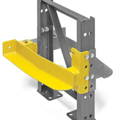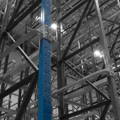Drive in rack is a FILO (first in last out) high-density pallet storage system. It allows you to store pallets as deep as you want to in storage lanes. It allows you to increase warehouse space by having fewer aisles.
When you are deciding what racking system will work best for you, there are a lot of things you need to take into consideration. If you are tight on space a drive-in pallet racking system may be a good choice for you. It allows to store a large number of pallets by having fewer aisles.
Standard pallet rack or selective racking only allows you to store pallets one deep. Drive-in systems or drive-thru systems increase your storage density by storing pallets in lanes as deep as you want. The forklift operator will take the first pallet and actually "drive in" the system with the pallet in the desired lane. When they get to the back of the system the pallet will either be put onto the floor or rest it on the steel rail.
The high-density storage system is unloaded the same way, with the forklift truck going into the system, picking up the pallet and reversing out of the system.

Pallet Rack Uprights: The uprights provide vertical support for the rack system and are what the drive in rails hang from. The uprights can be made from roll formed or structural steel.
Guide Rails:The guide rails and continuous rails and are what the pallets rest on and run from the front of the system to the back. The guide rails can be made from roll formed or hot rolled c-channel.
Horizontal Rails: The horizontal rails or beams are at the back and top of the rack system for drive in. For drive thru they are only at the top of the system. These beams are what hold the system together and keep it from swaying from left to right.
The main difference between these racking systems is drive-thru racks can be services from both sides of the system, whereas drive-thru racks can only be service on one side. Both are very similar high-density storage solution. Drive-thru pallet rack systems just give you a little more flexibility.
A drive in pallet rack system has beams across the back of the system at all pallet levels, that the last pallet can rest on. This horizontal beam across the back of the drive-in rack system keeps the forklift drivers from being able to drive through the back of the system. This makes drive in a FILO (first in last out) system where drive-thru rack systems can be a FIFO (first in first out) or a FILO.
Drive-in pallet racking is best suited for slower moving products that do not go bad due to the fact that the first pallet you put into the system, will be the last one you take out. Drive-thru pallet racking is better suited for quicker moving sku's as you can access the pallets from either side of the system.
Both systems are an excellent solution to increase floor space and storage space in your facility. These rack systems are commonly seen in cold storage applications because of the fact that freezer real estate is so valuable. The storage capacity of either type of system can be customized to fit your needs.
When designing your rack system you obviously need to make sure the layout works with the building structure and columns. You also need to pay particular attention damage prevention when designing. Here are some of the ways you can prevent damage.

Rub rails are installed at the bottom of the system and made from hot rolled c-channel. They are a continuous rail from the front of the system to the back of the system.
They prevent the bottom of the upright from taking damage from the forklift at the ground floor. This is very important because upright replacement in a drive-in system can be very costly, especially if it is an interior upright.

Cant legs or slant legs are used on the front upright of a drive in system to decrease the chance of a fork on a forklift from sweeping the leg of the front upright in the system.
Cant legs are typically made of structural steel.

Structural guide rails are preferable to roll formed rails to prevent them from being damaged by pallets. Pictured is a Steel King structural drive in rail that has a flare in the front to help guide the pallet into the system.
They feature a stop in the back to keep you from pushing a pallet off the back of the system. It also is flush in the front of the rack system to keep you from hitting the rail as you are lifting the pallet up.

Using structural uprights vs. roll formed uprights in your drive-in pallet rack system is another great way to prevent damage.
Structural cold rolled steel is heavier duty and more resistant to damage than say a roll formed teardrop upright. It is a little bit more expensive on the front end, but this can be money well spent when you take replacements costs into consideration in the future.
Structural uprights can be double posted as seen in the picture or made 4" wide vs. 3" wide to further increase its damage resistance.